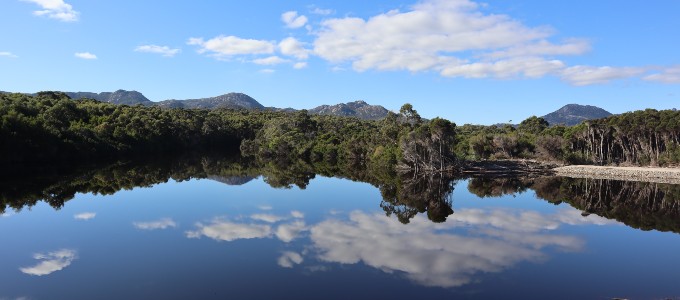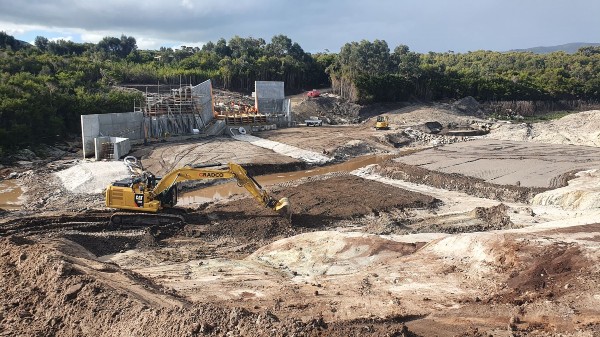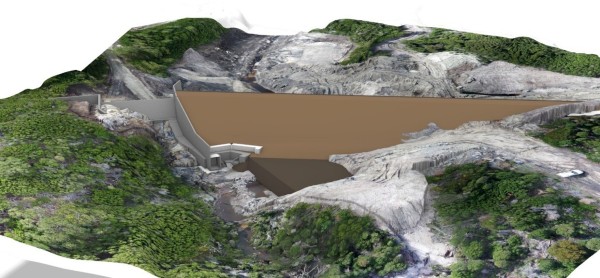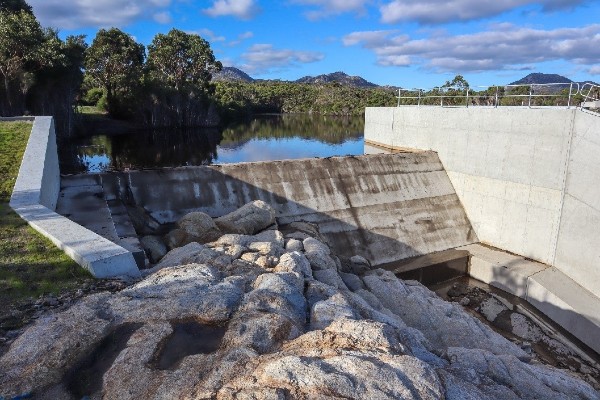Henderson Dam Upgrade

Client: TasWater
Location: Flinders Island, Bass Strait
Date: September 2020 - July 2022
Designing and delivering upgrades to a critical water supply on a remote island
Background
Henderson Dam, which is fed by the South Pats River, is an important component of the water supply system for Flinders Island in the Bass Strait. The dam has been supplying water to the island for many years, but it was beginning to show signs of age, the storage capacity was no longer adequate, and its design no longer aligned with best practice. The upgrade aimed to double the dam’s storage capacity, substantially increase the flood capacity, and refurbish elements of the structure.
During early stages of construction in 2021, excavation work uncovered variable conditions within the embankment and foundation. This required updates to several design elements, most notably the earthfill embankment, changing the scope of work from a planned raising of the crest to full construction of an 11m-high embankment.
TasWater engaged Entura to undertake detailed design of the upgrade works at Henderson Dam. The key elements of the detailed design work were a new spillway, new zoned earthfill embankment including a comprehensive filter and arrangement, design of erosion protection works, new outlet works, and dam instrumentation including survey, seepage and reservoir level monitoring.
Entura was also engaged to serve as Owner’s Engineer for engineering signoffs on the construction works.

Solution
Several unique challenges had to be overcome during the project’s design and delivery. We achieved a just-in-time design delivery with timely issuing of numerous site instructions, allowing construction progress to continue while ensuring that individual design elements were appropriately considered.
The creation of a 3D design model was also extremely valuable. Real-time site data was fed directly into the model, allowing necessary design changes to be assessed and implemented quickly. The model also enabled stakeholders to quickly comprehend and interact with the design.

Another challenge was the limited supply of traditional earthfill material available on the island, with material sourcing limited to the island’s generally sandy soils. The closest identified and very limited clay source, which was some 25 km from the site, was nearly depleted by the end of the project. The design was optimised to account for this limitation. The existing embankment and foundation soils, consisting of sandy material with low fines and high moisture content, were used in the shoulders of the new embankment. Stringent moisture content controls and on-site supervision were required to ensure that the material could be placed and compacted.
Having to place fill in winter was difficult for the team, as heaving was observed in the shoulder fill due to increased pore water pressure when material was marginally wet of typical moisture content specifications. This was caused by material with a narrow workable moisture window due to its low fines content and low plasticity. Generally, the moisture content was reduced to a manageable range by working the stockpiles to assist with air drying of the material. Modelling with SEEP/W software revealed that wick drains, which are more permeable fill layers, could be strategically placed to reduce pore pressures to facilitate compaction. Site trials validated this design concept, allowing the embankment construction to continue in periods when the material was wetter than desired during the winter months.
Because our team could not be on site full time, we had to adapt to solving problems remotely. Cost-effective and timely solutions were developed to ensure that key elements were built in accordance with the design intent, including remote reviewing and signoff of hold points. This process was made possible by utilising drone imagery in conjunction with detailed images of key locations, such as foundation defects and reinforcement details. Imagery was provided with dimensioning and survey information, and the detailed image packs allowed the Principal’s Engineer to interrogate the imagery remotely.

Services provided
- Detailed design
- Owner’s Engineer
- Hydraulic modelling
- Instrumentation and surveillance design
- 3D modelling
- Geological mapping
- Erodibility assessment
Outcome
Following a substantial rain event, the reservoir was filled for the first time in early May 2022. Filling took just 36 hours and during that time the spillway was in operation briefly. The commissioning inspection confirmed that the dam is in good operational condition, with key monitoring and surveillance mechanisms in place to ensure dam safety.
The improved Henderson Dam is now ready to provide the Flinders Island community with a reliable water supply for many years to come.



